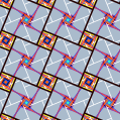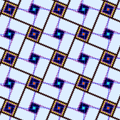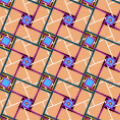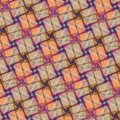File:006 A wallpaper.svg

Original file (SVG file, nominally 600 × 600 pixels, file size: 2 KB)
Captions
Captions
Summary
[edit]| Description006 A wallpaper.svg |
English: An article on Wikipedia calls "Pythagorean tiling" a periodic tiling by squares of two different sizes, where any tile adjoins, by any edge, exactly one tile of another size. Six drawings of Pythagorean tilings are overlaid. Four are similar, out of which two are symmetric to each other with respect to a vertical or horizontal axis. "Brown tiling" and "transparent tiling" will be the names of these symmetric tilings: two enlargements of the "white tiling" by a factor of two. In CSS code, the second column of the following table provides the six values of 'stroke' attributes, specified for the six tilings in the source code of the SVG image. The "violet tiling" is a copy of the white tiling with a scale ratio of square root of two: √2. In the four similar tilings, tan 22.5 o is the dimension ratio of a small tile to a large tile, and all lines are inclined at 22.5 or 67.5 degrees. Any transparent segment is an extension of a diagonal of a small white square, of which the center is the midpoint of this transparent segment. For any small brown square, the midpoint of an edge is a vertex of a small violet square. For any small violet square, the midpoint of an edge is a vertex of a small white square, concentric to this violet tile. About the source code of the drawing
Name CSS color Relative coord. of lineTo Size Minimal patterns
Small edge Large edge ratio Slope Size
white tiling #eed 17, 41 99, –41 √2 – 1 1 116
brown tiling #a38883 34, 82 198, –82 √2 – 1 1 232
transparent #420 34,–82 198, 82 √2 – 1 1 232
violet tiling #82a 58, 24 58,–140 √2 – 1 0 164
dark tiling #220 41, 11 41,–153 2 – √3 0 164
pink tiling #e48 36, 4 –36, 324 1 / 9 0 328
A Pythagorean tiling have an infinite number of repetitive patterns. Among them, minimal patterns are squares of same orientation and same dimension. Their sides are parallel to a pair of "minimal" translations, under which the tiling is invariant: two translations through a minimal distance in perpendicular directions. This minimal distance is the dimension of minimal patterns. This pair of translations generates the group of all translations that leave unchanged the tiling. Such minimal patterns are visible on other images: Français : Dans Wikipédia en anglais, un article appelle "pavage de Pythagore" un pavage périodique par des carrés de deux tailles différentes, où n’importe quel carré jouxte, par n’importe quel côté, exactement un carré d’une autre taille. Six dessins de pavages de Pythagore sont superposés. Quatre sont semblables, dont deux sont symétriques l’un de l’autre par rapport à une droite horizontale ou verticale. "Pavage brun" et "pavage transparent" seront les noms de ces pavages symétriques : deux agandissements du "pavage blanc" par un facteur deux. En code CSS, la deuxième colonne du tableau qui suit donne les six valeurs d’attributs 'stroke', spécifiées pour les six pavages dans le code source de l’image SVG. Le "pavage violet" est une copie du pavage blanc à l’échelle racine carrée de deux : √2. Dans les quatre pavages semblables, tan 22,5 o est le rapport des dimensions d’un petit à un grand élément du pavage, et toutes les traits sont inclinés à 22,5 ou 67,5 degrés. N’importe quel segment transparent est un prolongement d’une diagonale d’un petit carré blanc, dont le centre est le milieu de ce segment transparent. Pour tout petit carré brun, le milieu d’un côté est un sommet de petit carré violet. Pour tout petit carré violet, le milieu d’un côté est un sommet d’un petit carré blanc, concentrique à ce carré violet. Dans le code source du dessin
Nom Couleur CSS Coord. relatives des lineTo Rapport Motifs minimaux
Petit côté Grand côté des tailles Pente Taille
pavage blanc #eed 17, 41 99, –41 √2 – 1 1 116
pavage brun #a38883 34, 82 198, –82 √2 – 1 1 232
transparent #420 34,–82 198, 82 √2 – 1 1 232
pavage violet #82a 58, 24 58,–140 √2 – 1 0 164
pavage foncé #220 41, 11 41,–153 2 – √3 0 164
pavage rose #e48 36, 4 –36, 324 1 / 9 0 328
Un pavage de Pythagore a une infinité de motifs répétitifs. Parmi eux, les motifs minimaux sont des carrés de même orientation et même dimension. Les directions de leurs côtés sont celles d’une paire de translations "minimales", qui laissent le pavage invariant : deux translations sur une distance minimale dans des directions perpendiculaires. Cette distance minimale est la dimension des motifs minimaux. Cette paire de translations engendre le groupe de toutes les translations qui ne modifient pas le pavage. De tels motifs minimaux sont visibles dans d’autres images : |
| Date | |
| Source | Own work |
| Author | Baelde |
| Other versions |
|
| SVG development InfoField | This /Baelde was created with a text editor. |
Licensing
[edit]- You are free:
- to share – to copy, distribute and transmit the work
- to remix – to adapt the work
- Under the following conditions:
- attribution – You must give appropriate credit, provide a link to the license, and indicate if changes were made. You may do so in any reasonable manner, but not in any way that suggests the licensor endorses you or your use.
- share alike – If you remix, transform, or build upon the material, you must distribute your contributions under the same or compatible license as the original.
File history
Click on a date/time to view the file as it appeared at that time.
| Date/Time | Thumbnail | Dimensions | User | Comment | |
|---|---|---|---|---|---|
| current | 17:24, 20 March 2013 |  | 600 × 600 (2 KB) | Baelde (talk | contribs) | User created page with UploadWizard |
You cannot overwrite this file.
File usage on Commons
The following page uses this file:
Metadata
This file contains additional information such as Exif metadata which may have been added by the digital camera, scanner, or software program used to create or digitize it. If the file has been modified from its original state, some details such as the timestamp may not fully reflect those of the original file. The timestamp is only as accurate as the clock in the camera, and it may be completely wrong.
| Width | 600 |
|---|---|
| Height | 600 |
















